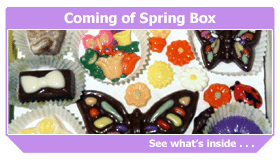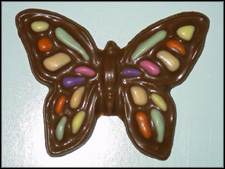RIKLBLOG
|
| Tomorrow |
| 20 June 2006 |
| Yesterday |
| Index |
| Eventide |
| SETI League |
| PriUPS Project |
| Bonus! |
| Contact |
What Makes for Smooth, Creamy Chocolate?
That was a stolen title. And this is a stolen paragraph:
Many people, when describing what happens after they bite off a piece of chocolate, would say that the chocolate melts in their mouth, then they swirl it around with their tongue to best enjoy the sweet, creamy sensation. Food scientists might describe the process differently. They'd observe that the tongue induces a shear flow within the melted chocolate layer between tongue and palate. According to Newton's law, the shear stress τ applied by tongue is the product of chocolate's bulk shear viscosity η and the shear rate, which itself is approximately the ratio of the tongue's velocity to the thickness of the melted chocolate layer. Chocolate rheology, however, is non-Newtonian; the viscosity depends on shear rate, time, and temperature. What typical consumers consider "smooth and creamy" corresponds to a viscosity of 1.5–3.5 Pa·s (pascal-seconds), at a representative shear rate of 20/s and body temperature 37 °C.
It was written by Erich J. Windhab, and I came across it while reading the June 2006 issue of Physics Today. This is one of the sources from which I normally obtain my cosmology, and now I shall have to consider it a chocolatic source as well. You will not be very surprised to find that Dr. Windhab is a "professor of food process engineering" and even less surprised that he practices this profession in Switzerland (at ETH Zürich).
What a remarkable article this is! I prefer to think that "old family recipes" are in part responsible for the delight I experience when tucking into a Teuscher champagne truffle, or one of the multilevular rectangular chocolates that Mrs. Nagle's husband lovingly prepares when he isn't overwhelmed by Valentine's day custom. But reading, to the extent I was able, Prof. Windhab's article, made me realize that chocolate is the triumph of rheology over reality.
I never thought I was deluding myself excessively when I decanted a chocolate from its wrapper, or when I bemoaned the state of the once-noble Sky Bar. But I will never look at a piece of chocolate again without contemplating particle morphology* parameters, surfactants, and flocculation. Of course, eating chocolate with one's eyes closed is an acceptable methodological substitution.
*Morphology of a different kind: On the other hand if you want to eat chocolate with your eyes open, take a look at these confections from Deb's Delectables! Wow!
| © 2006 |
| Richard Factor |


